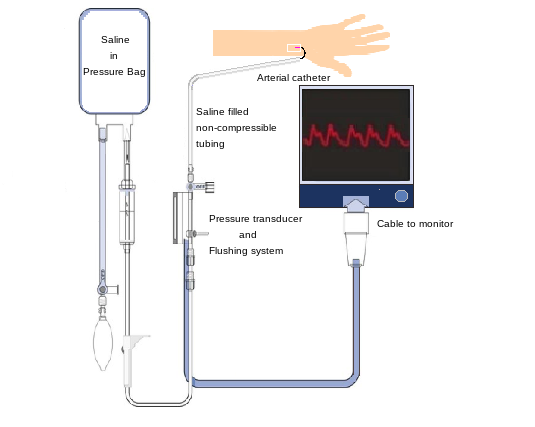[1]
Gardner RM. Direct blood pressure measurement--dynamic response requirements. Anesthesiology. 1981 Mar:54(3):227-36
[PubMed PMID: 7469106]
[2]
Frezza EE, Mezghebe H. Indications and complications of arterial catheter use in surgical or medical intensive care units: analysis of 4932 patients. The American surgeon. 1998 Feb:64(2):127-31
[PubMed PMID: 9486883]
[3]
Scheer B, Perel A, Pfeiffer UJ. Clinical review: complications and risk factors of peripheral arterial catheters used for haemodynamic monitoring in anaesthesia and intensive care medicine. Critical care (London, England). 2002 Jun:6(3):199-204
[PubMed PMID: 12133178]
[4]
Gershengorn HB, Garland A, Kramer A, Scales DC, Rubenfeld G, Wunsch H. Variation of arterial and central venous catheter use in United States intensive care units. Anesthesiology. 2014 Mar:120(3):650-64. doi: 10.1097/ALN.0000000000000008. Epub
[PubMed PMID: 24424071]
[5]
Gershengorn HB, Wunsch H, Scales DC, Zarychanski R, Rubenfeld G, Garland A. Association between arterial catheter use and hospital mortality in intensive care units. JAMA internal medicine. 2014 Nov:174(11):1746-54. doi: 10.1001/jamainternmed.2014.3297. Epub
[PubMed PMID: 25201069]
[6]
Kaki A, Blank N, Alraies MC, Kajy M, Grines CL, Hasan R, Htun WW, Glazier J, Mohamad T, Elder M, Schreiber T. Access and closure management of large bore femoral arterial access. Journal of interventional cardiology. 2018 Dec:31(6):969-977. doi: 10.1111/joic.12571. Epub 2018 Nov 19
[PubMed PMID: 30456854]
[7]
Nuttall G, Burckhardt J, Hadley A, Kane S, Kor D, Marienau MS, Schroeder DR, Handlogten K, Wilson G, Oliver WC. Surgical and Patient Risk Factors for Severe Arterial Line Complications in Adults. Anesthesiology. 2016 Mar:124(3):590-7. doi: 10.1097/ALN.0000000000000967. Epub
[PubMed PMID: 26640979]
[8]
Paik JJ, Hirpara R, Heller JA, Hummers LK, Wigley FM, Shah AA. Thrombotic complications after radial arterial line placement in systemic sclerosis: A case series. Seminars in arthritis and rheumatism. 2016 Oct:46(2):196-199. doi: 10.1016/j.semarthrit.2016.03.015. Epub 2016 Mar 31
[PubMed PMID: 27139167]
Level 2 (mid-level) evidence
[9]
Franco-Sadud R, Schnobrich D, Mathews BK, Candotti C, Abdel-Ghani S, Perez MG, Rodgers SC, Mader MJ, Haro EK, Dancel R, Cho J, Grikis L, Lucas BP, SHM Point-of-care Ultrasound Task Force, Soni NJ. Recommendations on the Use of Ultrasound Guidance for Central and Peripheral Vascular Access in Adults: A Position Statement of the Society of Hospital Medicine. Journal of hospital medicine. 2019 Sep:14(9):E1-E22. doi: 10.12788/jhm.3287. Epub
[PubMed PMID: 31561287]
[10]
Chim H, Bakri K, Moran SL. Complications related to radial artery occlusion, radial artery harvest, and arterial lines. Hand clinics. 2015 Feb:31(1):93-100. doi: 10.1016/j.hcl.2014.09.010. Epub 2014 Nov 25
[PubMed PMID: 25455360]
[11]
Hignett R, Stephens R. Radial arterial lines. British journal of hospital medicine (London, England : 2005). 2006 May:67(5):M86-8
[PubMed PMID: 16729631]
[13]
O'Horo JC, Maki DG, Krupp AE, Safdar N. Arterial catheters as a source of bloodstream infection: a systematic review and meta-analysis. Critical care medicine. 2014 Jun:42(6):1334-9. doi: 10.1097/CCM.0000000000000166. Epub
[PubMed PMID: 24413576]
Level 3 (low-level) evidence
[14]
Koh DB, Gowardman JR, Rickard CM, Robertson IK, Brown A. Prospective study of peripheral arterial catheter infection and comparison with concurrently sited central venous catheters. Critical care medicine. 2008 Feb:36(2):397-402. doi: 10.1097/CCM.0b013e318161f74b. Epub
[PubMed PMID: 18216598]
[15]
Maki DG, Kluger DM, Crnich CJ. The risk of bloodstream infection in adults with different intravascular devices: a systematic review of 200 published prospective studies. Mayo Clinic proceedings. 2006 Sep:81(9):1159-71
[PubMed PMID: 16970212]
[16]
O'Grady NP, Alexander M, Burns LA, Dellinger EP, Garland J, Heard SO, Lipsett PA, Masur H, Mermel LA, Pearson ML, Raad II, Randolph AG, Rupp ME, Saint S, Healthcare Infection Control Practices Advisory Committee (HICPAC). Guidelines for the prevention of intravascular catheter-related infections. Clinical infectious diseases : an official publication of the Infectious Diseases Society of America. 2011 May:52(9):e162-93. doi: 10.1093/cid/cir257. Epub 2011 Apr 1
[PubMed PMID: 21460264]
[17]
Ruschulte H, Franke M, Gastmeier P, Zenz S, Mahr KH, Buchholz S, Hertenstein B, Hecker H, Piepenbrock S. Prevention of central venous catheter related infections with chlorhexidine gluconate impregnated wound dressings: a randomized controlled trial. Annals of hematology. 2009 Mar:88(3):267-72. doi: 10.1007/s00277-008-0568-7. Epub 2008 Aug 5
[PubMed PMID: 18679683]
[18]
Ho KM, Litton E. Use of chlorhexidine-impregnated dressing to prevent vascular and epidural catheter colonization and infection: a meta-analysis. The Journal of antimicrobial chemotherapy. 2006 Aug:58(2):281-7
[PubMed PMID: 16757502]
[19]
Grover S, Currier PF, Elinoff JM, Katz JT, McMahon GT. Improving residents' knowledge of arterial and central line placement with a web-based curriculum. Journal of graduate medical education. 2010 Dec:2(4):548-54. doi: 10.4300/JGME-D-10-00029.1. Epub
[PubMed PMID: 22132276]
Level 3 (low-level) evidence
[20]
Chee BC, Baldwin IC, Shahwan-Akl L, Fealy NG, Heland MJ, Rogan JJ. Evaluation of a radial artery cannulation training program for intensive care nurses: a descriptive, explorative study. Australian critical care : official journal of the Confederation of Australian Critical Care Nurses. 2011 May:24(2):117-25. doi: 10.1016/j.aucc.2010.12.003. Epub 2011 Jan 5
[PubMed PMID: 21211987]


